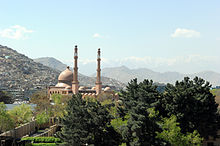User:Ashlynndavies/sandbox
| Part of a series on the |
| Culture of Afghanistan |
|---|
 |
| History |
| People |
| Languages |
| Mythology |
| Cuisine |
| Festivals |
| Religion |
| Sport |
Architecture in Afghanistan
[edit]The architecture of Afghanistan is reflective of a range of influences that stem from the vast and colourful history of the country – both due to the cultural transfer that occurred with travel along the Silk Road as well as the landlocked position of the country in the south of Central Asia. This factor in particular allowed for an almost constant cycle of invasion from surrounding powers and empires, with each greatly affecting the architecture of the time. Architectural influences in the pre-Islamic period include Early Iranian, Early Buddhist and Sasanian architecture, followed by Samanid, Ghaznavid and Seljuk influence after the 9th century Muslim conquest of Afghanistan. Timurid and then Late Islamic architecture characterised construction since that time, with more contemporary focuses beginning in 2002 in the wake of the decades of war and destruction the country faced.
References I wish to include in my article
[edit]- Frye, R. (1946). Notes on the history of architecture in Afghanistan. Ars Islamica, 11/12, pp.200-202.
- Hansen, E. et al. (2015). The Ghurid Portal of the Friday Mosque of Herat, Afghanistan: conservation of a historical monument. Aarhus, Denmark: University of Aarhus.
- Kazimee, B. and Najimi, A. (2017). Urban heritage of Kabul and post-war recovery efforts. International Journal of Heritage Architecture: Studies, Repairs and Maintenance, 1(1), pp.60-67.
- Knobloch, E. (2002). The archaeology & architecture of Afghanistan. Stroud, Gl: Tempus.
- Lee, J. (2006). Monuments of Bamiyan Province, Afghanistan. Iran, 44(1), pp.229-252.
- Najimi, A. (2016). Studies in vernacular architecture in Afghanistan: Training in conservation of historic structures in Kabul Old City. International Journal of Environmental Studies, 73(4), pp.512-523.
- Najimi, A. (2019). Architectural education in Afghanistan: Evolution, challenges and opportunities. International Journal of Architectural Research, 6(2), pp.158-180.
- Szabo, A., Barfield, T. and Sekler, E. (1991). Afghanistan: An atlas of indigenous domestic architecture. 1st ed. Austin: University of Texas Press.
- Tirard-Collet, O. (1998). After the war: The condition of historical buildings and monuments in Herat, Afghanistan. Iran, 36, pp.123-138.

